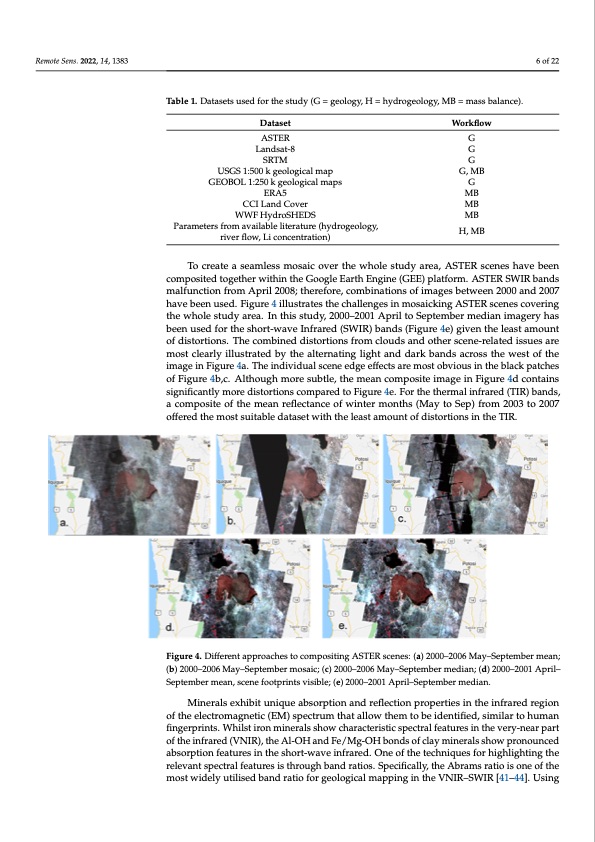
PDF Publication Title:
Text from PDF Page: 006
Remote Sens. 2022, 14, x FOR PEER REVIEW 6 of 21 Remote Sens. 2022, 14, 1383 6 of 22 Table 1. Datasets used for the study (G = geology, H = hydrogeology, MB = mass balance). Table 1. Datasets used for the study (G = geology, H = hydrogeology, MB = mass balance). Dataset Workflow ASTER G G Dataset Workflow ASTER G G Landsat-8 Landsat-8 SRTMSRTM G G G, MB USGS 1:500 k geological map USGS 1:500 k geological map G, MB G GEOBOL 1:250 k geological maps G MB MB GEOBOL 1:250 k geological maps ERA5 ERA5 CCI Land Cover MB MB MB MB CCI Land Cover WWF HydroSHEDS WWF HydroSHEDS Parameters from available literature (hydrogeology, Parameters from available literature (hydrogeology, river H, MB river flow, Li concentration) H, MB flow, Li concentration) To create a seamless mosaic over the whole study area, ASTER scenes have been To create a seamless mosaic over the whole study area, ASTER scenes have been composited together within the Google Earth Engine (GEE) platform. ASTER SWIR bands composited together within the Google Earth Engine (GEE) platform. ASTER SWIR bands malfunction from April 2008; therefore, combinations of images between 2000 and 2007 malfunction from April 2008; therefore, combinations of images between 2000 and 2007 have been used. Figure 4 illustrates the challenges in mosaicking ASTER scenes covering have been used. Figure 4 illustrates the challenges in mosaicking ASTER scenes covering the whole study area. In this study, 2000–2001 April to September median imagery has the whole study area. In this study, 2000–2001 April to September median imagery has been used for the short-wave Infrared (SWIR) bands (Figure 4e) given the least amount been used for the short-wave Infrared (SWIR) bands (Figure 4e) given the least amount of of distortions. The combined distortions from clouds and other scene-related issues are distortions. The combined distortions from clouds and other scene-related issues are most most clearly illustrated by the alternating light and dark bands across the west of the clearly illustrated by the alternating light and dark bands across the west of the image in image in Figure 4a. The individual scene edge effects are most obvious in the black patches Figure 4a. The individual scene edge effects are most obvious in the black patches of Fig- of Figure 4b,c. Although more subtle, the mean composite image in Figure 4d contains ure 4b,c. Although more subtle, the mean composite image in Figure 4d contains signifi- significantly more distortions compared to Figure 4e. For the thermal infrared (TIR) bands, cantly more distortions compared to Figure 4e. For the thermal infrared (TIR) bands, a accoomppoosistieteofofthtehemmeaenanrefrleflcteacntcaencoef wofinwteirntmeronmthosnt(Mhsa(yMtoaySetpo)Sferopm) f2ro0m03 2to002300t7o o2f0-07 offeerreeddththeemmooststsusuitiatbalbeledadtatsaestewtwithitthethlealestaastmaomuonutnoftdoifsdtoisrtiorntisoinstihnetThIeRT.IR. Figure 4. Different approaches to compositing ASTER scenes: (a) 2000–2006 May–September mean; Figure 4. Different approaches to compositing ASTER scenes: (a) 2000–2006 May–September mean; (b) 2000–2006 May–September mosaic; (c) 2000–2006 May–September median; (d) 2000–2001 April– (b) 2000–2006 May–September mosaic; (c) 2000–2006 May–September median; (d) 2000–2001 April– September mean, scene footprints visible; (e) 2000–2001 April–September median. September mean, scene footprints visible; (e) 2000–2001 April–September median. Minerals exhibit unique absorption and reflection properties in the infrared region of Minerals exhibit unique absorption and reflection properties in the infrared region the electromagnetic (EM) spectrum that allow them to be identified, similar to human fin- of the electromagnetic (EM) spectrum that allow them to be identified, similar to human gerprints. Whilst iron minerals show characteristic spectral features in the very-near part fingerprints. Whilst iron minerals show characteristic spectral features in the very-near part of the infrared (VNIR), the Al-OH and Fe/Mg-OH bonds of clay minerals show pro- of the infrared (VNIR), the Al-OH and Fe/Mg-OH bonds of clay minerals show pronounced absorption features in the short-wave infrared. One of the techniques for highlighting the relevant spectral features is through band ratios. Specifically, the Abrams ratio is one of the most widely utilised band ratio for geological mapping in the VNIR–SWIR [41–44]. UsingPDF Image | Lithium Brine Deposit Formation

PDF Search Title:
Lithium Brine Deposit FormationOriginal File Name Searched:
remotesensing-14-01383-v2.pdfDIY PDF Search: Google It | Yahoo | Bing
Product and Development Focus for Infinity Turbine
ORC Waste Heat Turbine and ORC System Build Plans: All turbine plans are $10,000 each. This allows you to build a system and then consider licensing for production after you have completed and tested a unit.Redox Flow Battery Technology: With the advent of the new USA tax credits for producing and selling batteries ($35/kW) we are focussing on a simple flow battery using shipping containers as the modular electrolyte storage units with tax credits up to $140,000 per system. Our main focus is on the salt battery. This battery can be used for both thermal and electrical storage applications. We call it the Cogeneration Battery or Cogen Battery. One project is converting salt (brine) based water conditioners to simultaneously produce power. In addition, there are many opportunities to extract Lithium from brine (salt lakes, groundwater, and producer water).Salt water or brine are huge sources for lithium. Most of the worlds lithium is acquired from a brine source. It's even in seawater in a low concentration. Brine is also a byproduct of huge powerplants, which can now use that as an electrolyte and a huge flow battery (which allows storage at the source).We welcome any business and equipment inquiries, as well as licensing our turbines for manufacturing.| CONTACT TEL: 608-238-6001 Email: greg@infinityturbine.com | RSS | AMP |